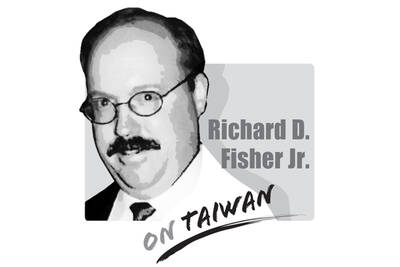Taiwan People’s Party (TPP) Legislator Huang Kuo-chang (黃國昌) on Monday last week played an audio recording at a hearing of the legislature’s Judiciary and Organic Laws and Statutes Committee to accuse a prosecutor of interrogating a suspect with a harsh tone. Huang later said the tape was an artificial intelligence (AI)-generated “demo tape,” triggering controversy over mixing fact with fiction to misrepresent judicial proceedings.
In the hearing, Huang questioned Minister of Justice Cheng Ming-chien (鄭銘謙) on the prosecutors’ improper interrogations of suspects and played what he called “an interrogation audio tape” that appeared to depict a female prosecutor harshly questioning a suspect, surnamed Chu (朱), who resembled Chu Yea-hu (朱亞虎), a defendant in the Core Pacific City (京華城) development project case who had confessed to bribing former Taipei mayor Ko Wen-je (柯文哲).
When the minister warned that broadcasting material related to ongoing legal proceedings is illegal, Huang retracted his remarks and said the tape is “a demonstration tape,” without specifying its origin, to illustrate a harsh interrogation. Huang later told media that the tape was “an AI-processed piece” made by himself.
However, the tape released by Huang has been widely cited as “the prosecutor’s interrogation of Chu Yea-hu.” Even TPP-funded media and TPP members’ social media posts call it “evidence of improper interrogation of the Core Pacific city case’s defendant Chu.”
The party’s caucus deputy convener Chang Chi-kai (張啟楷) also said that the tape is “a part of the prosecutors’ interrogation recording, which party members have heard several times.”
Huang’s tape has triggered heated controversy. The Taipei District Prosecutors’ Office has launched an investigation into Huang’s tape on suspicion of misusing and counterfeiting investigation material to misrepresent ongoing legal proceedings. If the tape really is of an interrogation, Huang could have contravened the Code of Criminal Procedure (刑事訴訟法) by revealing classified materials from ongoing court proceedings and the Personal Data Protection Act (個人資料保護法) for violating the privacy of defendants.
On the other hand, if the tape actually is an AI-generated or fabricated piece derived from interrogation materials, Huang could have committed document forgery to misrepresent judicial and prosecutorial operations.
It should be further noted that Huang and the TPP have recently proposed an amendment to the Court Organization Act (法院組織法) to allow court proceedings to be broadcast live, which has aroused concern, and opposition from legal associations and civil rights groups.
To live stream trials is rare even among advanced democracies. The US, Germany and Japan permit video recording only under limited conditions. In Taiwan, the transparency of court trials has been and could be gradually advanced through documents disclosure, citizen judges and public observations. To broadcast trials without complementary measures would not only disrupt the legal process, but also put excessive stress on participants, jeopardize the privacy of victims and witnesses, and threaten fairness.
The Judges Association issued a statement questioning the source of Huang’s audio file, adding that such an approach could mislead the public, as well as suggesting that there is a risk of using congressional questioning to interfere with individual cases. Huang’s move has validated concerns that the potential live streaming of court activities could be misused and edited to manipulate public opinion and influence trials.
Huang’s tape has put the TPP on the verge of contravening the law by improperly interfering with the Core Pacific City case, and has caused harm to legislative discipline. More importantly, it justifies the ongoing nationwide recall of legislators who know the law, but willingly break it.

On Sept. 3 in Tiananmen Square, the Chinese Communist Party (CCP) and the People’s Liberation Army (PLA) rolled out a parade of new weapons in PLA service that threaten Taiwan — some of that Taiwan is addressing with added and new military investments and some of which it cannot, having to rely on the initiative of allies like the United States. The CCP’s goal of replacing US leadership on the global stage was advanced by the military parade, but also by China hosting in Tianjin an August 31-Sept. 1 summit of the Shanghai Cooperation Organization (SCO), which since 2001 has specialized
In an article published by the Harvard Kennedy School, renowned historian of modern China Rana Mitter used a structured question-and-answer format to deepen the understanding of the relationship between Taiwan and China. Mitter highlights the differences between the repressive and authoritarian People’s Republic of China and the vibrant democracy that exists in Taiwan, saying that Taiwan and China “have had an interconnected relationship that has been both close and contentious at times.” However, his description of the history — before and after 1945 — contains significant flaws. First, he writes that “Taiwan was always broadly regarded by the imperial dynasties of
The Chinese Communist Party (CCP) will stop at nothing to weaken Taiwan’s sovereignty, going as far as to create complete falsehoods. That the People’s Republic of China (PRC) has never ruled Taiwan is an objective fact. To refute this, Beijing has tried to assert “jurisdiction” over Taiwan, pointing to its military exercises around the nation as “proof.” That is an outright lie: If the PRC had jurisdiction over Taiwan, it could simply have issued decrees. Instead, it needs to perform a show of force around the nation to demonstrate its fantasy. Its actions prove the exact opposite of its assertions. A
A large part of the discourse about Taiwan as a sovereign, independent nation has centered on conventions of international law and international agreements between outside powers — such as between the US, UK, Russia, the Republic of China (ROC) and Japan at the end of World War II, and between the US and the People’s Republic of China (PRC) since recognition of the PRC as the sole representative of China at the UN. Internationally, the narrative on the PRC and Taiwan has changed considerably since the days of the first term of former president Chen Shui-bian (陳水扁) of the Democratic